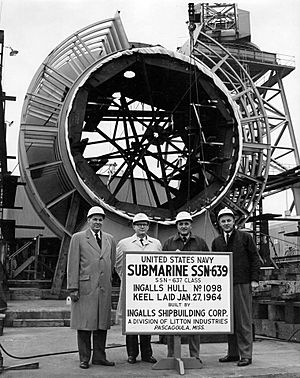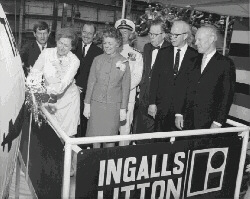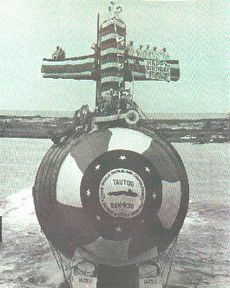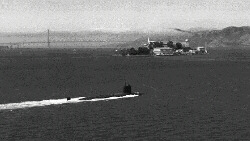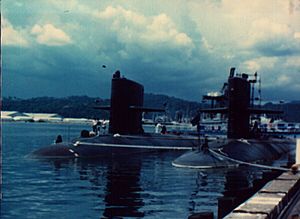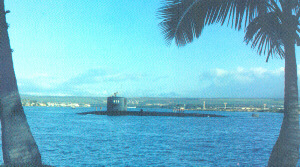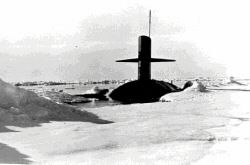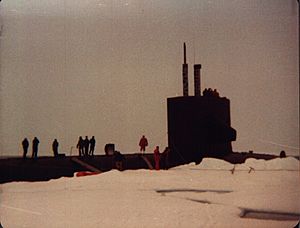USS Tautog (SSN-639) facts for kids
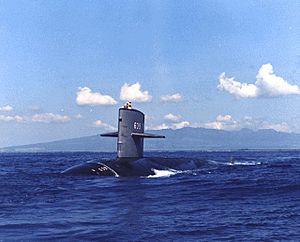
USS Tautog (SSN-639) off the Hawaiian Islands
|
|
Quick facts for kids History |
|
|---|---|
| Name | USS Tautog |
| Namesake | The tautog, a type of wrasse. |
| Ordered | 30 November 1961 |
| Builder | Ingalls Shipbuilding, Pascagoula, Mississippi |
| Laid down | 27 January 1964 |
| Launched | 15 April 1967 |
| Sponsored by | Pauline Lafon Gore |
| Commissioned | 17 August 1968 |
| Decommissioned | 31 March 1997 |
| Stricken | 31 March 1997 |
| Identification | Hull number: SSN-639 |
| Motto | Silent Vigilance |
| Nickname(s) | "The Terrible T" |
| Fate | Scrapping via Ship and Submarine Recycling Program completed 30 November 2004 |
| Badge | 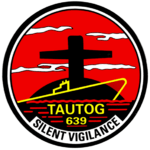 |
| General characteristics | |
| Class and type | Sturgeon-class attack submarine |
| Displacement |
|
| Length | 89 m (292 ft) |
| Beam | 9.7 m (32 ft) |
| Draft | 8.8 m (29 ft) |
| Propulsion | S5W nuclear reactor |
| Speed | >20kt |
| Test depth | >400ft |
| Complement |
|
The USS Tautog (SSN-639) was a special type of attack submarine in the United States Navy. It was named after the tautog, a fish found along the Northern Atlantic coast. This powerful submarine served for many years, from August 17, 1968, until March 31, 1997. Its motto was Silent Vigilance, meaning it watched carefully and quietly.
Contents
Building a Mighty Submarine
The plan to build the Tautog was approved on November 30, 1961. It was built by Ingalls Shipbuilding in Pascagoula, Mississippi. The first part of its construction, called the keel laying, happened on January 27, 1964.
The submarine was officially named on March 15, 1967. Mrs. Pauline Lafon Gore, the wife of a U.S. Senator, broke a bottle of champagne on its hull. This ceremony is called a christening. The Tautog was officially put into service on August 17, 1968. Commander Buele G. Balderston was its first captain.
Early Adventures and First Missions
On August 30, 1968, the Tautog left Pascagoula to join the United States Pacific Fleet. It traveled through the Panama Canal and arrived in Pearl Harbor, Hawaii, on September 23, 1968. There, it became the lead ship for Submarine Squadron 12.
During 1969, the Tautog completed its first tests and training trips. Most of these happened near the Hawaiian Islands. In early 1969, it visited Puget Sound Naval Shipyard for more tests and repairs. After finishing its training in September 1969, it had more repairs, including replacing its diesel generator.
The Tautog was ready for normal operations by February 19, 1970. It practiced using torpedos and sonar (sound detection). In 1970, it earned the Battle Efficiency "E" award for its excellent performance. It also received a Navy Unit Commendation for its service around June 1969.
In 1970, the Tautog sailed with the Seventh Fleet in the Western Pacific. It visited places like the Philippines, Hong Kong, Okinawa, Japan, and Korea. When it returned to Pearl Harbor, it received another award, the Meritorious Unit Commendation. This was for its missions between October 1970 and April 1971.
The Underwater Bump: Tautog's Collision
On June 20, 1970, the Tautog was on patrol in the North Pacific Ocean. It was near a major base for Soviet submarines. The Tautog was secretly following a Soviet submarine called the K-108.
The two submarines got very close to each other without the Soviet crew knowing. The Tautogs equipment showed zero distance between them at times. Suddenly, the K-108 bumped into the top of the Tautogs sail. The K-108 lost one of its screws (propellers) in the collision.
The Tautog suffered damage to its sail. Its crew heard sounds that made them think the K-108 was sinking. However, the K-108 was able to return to its base. Later, a piece of the K-108s propeller was found stuck in the Tautogs sail. Luckily, no one was hurt on either submarine.
For many years, both the United States and the Soviet Union kept this event a secret. The Tautog's sail was permanently bent by two degrees after the collision. This made it tricky to put the submarine in dry-dock for repairs. The full story became public in 1999 in a book called Blind Man's Bluff: The Untold Story Of American Submarine Espionage.
Exploring the Pacific and Beyond
On October 9, 1970, the Tautog began its first deployment to East Asia. It joined the United States Seventh Fleet in Okinawa. During this time, it focused on training for antisubmarine warfare, which means hunting other submarines. It often trained with the Seventh Fleet and once with a British Royal Navy ship, HMS Aurora.
The submarine visited ports like U.S. Naval Base Subic Bay in the Philippines, Hong Kong, Yokosuka, Japan, and Pusan, South Korea. It finished this tour on March 28, 1971, and returned to Pearl Harbor. For the rest of 1971 and early 1972, it continued training in Hawaii.
In March 1972, the Tautog went on a special mission. It stopped in Guam and Subic Bay. After this mission, it earned another Navy Unit Commendation. It also visited Hong Kong before returning to Pearl Harbor in August 1972.
In January 1973, the Tautog went into Pearl Harbor Naval Shipyard for its first major check-up. This was completed in April 1974. It then continued local operations, with a trip to the Pacific Northwest in the summer of 1974.
In May 1975, the Tautog began more special missions in the Central and Western Pacific. This included time in drydock at Guam and exercises in the Philippines. It visited Subic Bay and Hong Kong again. The crew received the Navy Expeditionary Medal for successfully completing their mission.
Helping During the Uganda Crisis
The Tautog spent 1976 training in Hawaii. In January 1977, it sailed for a friendly visit to Mombasa, Kenya. It stayed there for a month, allowing the crew to explore and welcoming visitors aboard.
After leaving Mombasa in February 1977, the Tautog was ordered to change course. President of Uganda Idi Amin had held Americans in Uganda. The Tautog joined a special group of ships, including the aircraft carrier USS Enterprise (CVN-65). This group sailed to the East African coast. Their presence showed America's readiness to protect its citizens in Uganda.
Eventually, Amin released the hostages. The Tautog then continued its journey, arriving in Guam in March 1977. It visited Chinhae, South Korea, and returned to Subic Bay for more special operations. After another visit to Hong Kong, the Tautog arrived back in Pearl Harbor in July 1977. It then prepared for a major overhaul and a new reactor core at Mare Island Naval Shipyard in California. This big repair job lasted about 15 months.
Arctic Expeditions and Final Missions
After its major overhaul, the Tautog returned to Pearl Harbor in July 1979. It then went on another deployment to the Western Pacific in March 1980. For its excellent work during this time, it received the Navy Expeditionary Medal. In September 1980, the ship earned several awards for its efficiency and engineering. It visited places like Diego Garcia, the Philippines, Perth, Australia, and Guam.
In 1981, the Tautog sailed west again, becoming the first nuclear submarine to travel through the Malacca Straits. It visited Singapore, the Philippines, Australia, Diego Garcia, and Japan. In 1982, it earned more awards for its engineering and damage control.
In the winter of 1982, the Tautog went on an amazing journey to the Arctic. It operated under the ice for two months. It even surfaced at the North Pole with another submarine, USS Aspro. This was a rare event, especially in winter.
The Tautog returned to the Arctic in the summer of 1983. To celebrate reaching the North Pole, the crew had a picnic and even dog-sled races "around the world" on the ice.
In 1984, the Tautog went on another Western Pacific deployment. It operated in the Northern Pacific and visited the Philippines, Thailand, and Japan. It received another Navy Expeditionary Medal. After returning to Pearl Harbor in November 1984, it had a short break.
In October 1985, the Tautog began another deployment to the Western Pacific and Indian Ocean. It visited Guam, Singapore (for Christmas), Diego Garcia, Perth, Australia, the Philippines, and Chinhae, South Korea.
In October 1986, the Tautog started another major overhaul at Puget Sound Naval Shipyard in Washington. After many changes and tests, it returned to Pearl Harbor on May 30, 1989.
In May 1990, the Tautog went on its eighth Western Pacific deployment. It visited Singapore, Hong Kong, Subic Bay, and Yokosuka, Japan. It even experienced a huge typhoon that delayed its entry into Subic Bay. Back in Pearl Harbor in November 1990, it prepared for its third Arctic trip. In April 1991, the Tautog joined the Aspro again for three weeks of operations under the Arctic ice.
In January 1992, the Tautog successfully fired a torpedo and sank a target ship called ex-Darter near Oahu. In the summer of 1992, it went on another Western Pacific deployment, spending about 150 days at sea.
In October 1993, the Tautog was sent on an urgent Western Pacific mission. It took part in a joint exercise with the Japanese Maritime Self Defense Force and visited Hong Kong. In February 1995, it began its 11th Western Pacific deployment, working with Japanese, Korean, and British naval forces. The crew visited Guam, Hong Kong, Yokosuka, Sasebo, Okinawa, Chinhae, and Subic Bay. The Tautog earned another Navy Expeditionary Medal for this successful trip.
In February 1996, a small accident happened. While moving in Pearl Harbor, strong winds pushed the Tautog off course. It lightly bumped into the harbor bank, causing minor damage to its sonar dome. An investigation was held to find out what happened.
In July 1996, the Tautog began its final deployment to the eastern Pacific. It supported weapons testing and hosted many midshipman training cruises. It visited San Diego and Esquimalt in British Columbia. The Tautog made its 1,119th and last dive on October 13, 1996. Its inactivation ceremony was held on October 25, 1996. After this, the Tautog left Pearl Harbor for the last time, heading to Puget Sound Naval Shipyard.
Saying Goodbye: Decommissioning
The Tautog was officially taken out of service on March 31, 1997. It was removed from the Navy's list of active ships on the same day. Its recycling process, which involved taking it apart at Puget Sound Naval Shipyard, began on March 15, 2003. This process was completed on November 30, 2004.
Remembering the Tautog
The sail of the Tautog was saved and is now on display at the Galveston Naval Museum in Seawolf Park in Galveston, Texas. It was damaged when Hurricane Ike hit the area in 2008, but it remains a memorial to the submarine's long service.
Images for kids
-
Tautog's preserved sail has tipped over in this view of damage at Galveston Naval Museum, in Seawolf Park


